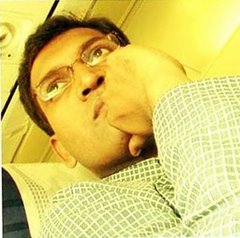“God is not a spectator, but a fellow-sufferer … to embrace the bitterness of the strange world he has made. - From Science and Providence.
Does the Sun differentiate between the rich and the poor or the upper caste or the lower, when it emits its life saving energy? Do the ocean waves shy away from touching the feet of Dalits (untouchables as they were once called in the pre independence era of India)?
Nature doesn’t differentiate between the extremes of the world, so doesn’t GOD; the Maker of the Universe. It’s us - Human beings who create these differences and rifts within. Its said that untouchability no longer exists in this part of the world, but is it really so? A deep probe in rural India - would leave the so called mentors of society with lots to think and ponder about. But, there is always a ray of hope, and it comes from non other than our maker himself.

Lord Balaji- the richest Hindu God (with a turn over of more than Rs. 800 crore annually) is going out with his priests to the Dalit colonies, to spend time with his set of underprivileged Dalit children and erase the caste discrimination that they face in this part of the world. Tirumala Tirupati Dewastham (the body which manages the Lord Balaji temple in Tirumala (Andhra Pradesh) – needs to be applauded for thinking of such a novel idea. Tirumala Tirupati Devasthanams (TTD) has decided to initiate the Dalita Govindam programme, in an effort to propagate the message of “Equality in the Eyes of God” in the Hindu religion.
As part of the programme, the idol of Lord Venkateswara will be taken to a Dalitwada (SC colony) by the temple priests and sacred rituals will be performed there after which, the temple priests will give out Veda Ashirvadam en masse to the residents of the colony and share the Srivari Prasadam with the devotees. To add to this, Lord Venkateswara along with its retinue of priests will spend a night in the Dalitwada among its residents. Until now, the Veda Ashirvadam was given only to the VVIPs who visited the temple for Lord Venkateswara’s darshan, as it’s said...
“When a man takes one step toward God, God takes more steps toward that man than there are sands in the worlds of time.” - The Work of the Chariot



 The Nizam of Hyderabad, as he was known, cut a curious figure. A frail, tiny man, and a devout Muslim, known to be notorious for his meanness - he wore the same tattered fez for 35 years, dressed in rumpled cotton pyjamas, and ate all his meals off a tin plate, while sitting on a mat in his bedroom surrounded by overflowing wastepaper baskets. But he was, back then, the richest man on the planet. In 1948, he deposited £1m - in those days, a staggeringly large sum - with the Westminster Bank in London.
The Nizam of Hyderabad, as he was known, cut a curious figure. A frail, tiny man, and a devout Muslim, known to be notorious for his meanness - he wore the same tattered fez for 35 years, dressed in rumpled cotton pyjamas, and ate all his meals off a tin plate, while sitting on a mat in his bedroom surrounded by overflowing wastepaper baskets. But he was, back then, the richest man on the planet. In 1948, he deposited £1m - in those days, a staggeringly large sum - with the Westminster Bank in London.
